Chinese Paper-cuts 剪纸 jiǎn zhǐ
Like so many Chinese art-forms, paper-cuts have a very long history, this led UNESCO to add Chinese paper-cuts ➚ to the list of ‘Intangible Cultural Heritage of Humanity’ in 2009. It is an art-form accessible to everyone and has been particularly strong in rural areas because it is so easy for anyone to have a go; just take scissors or a knife and cut away at some paper. They can be simple, made in a minute, to very intricate ones taking many hours or even months to make. It’s an art-form that gets very little space in the academic books on Chinese art and history which is a great shame.
Short history of Paper-cuts
You may think that paper-cuts could not pre-date the Chinese invention of paper in the Han dynasty 2,000 years ago but some early records show that the art-form started off as ‘leaf-cuts’ where large leaves were cut into decorative patterns as long ago as the Zhou dynasty. The rich could apply the same technique to silver foil and leather; remnants of these have been found from the Warring States period (476-221 BCE ). When paper did come along the designs could be more intricate (no leaf veins to accommodate) and more durable than leaves. Paper-cuts became widespread during the Tang dynasty (618 - 907). The great Tang poet Du Fu mentions them in one of his poems. Since the Tang dynasty paper-cuts were put in the hair as decorations - even by men. The great Song dynasty poet Su Dongpo is said to have put paper-cut ‘Spring flags’ in his hair, much to the amusement of his family. Later in the Yuan dynasty Marco Polo describes a mock battle on Hangzhou's West Lake where it is likely that the boats were bedecked with red, gold and silver paper-cuts.
A traditional house had paper rather than glass windows in summer so paper-cuts would often be placed against the window to make pleasing back-lit pattern at night for passers by. These are known as 窗花 chuāng huā literally ‘Window flowers’. These take on a heightened form when used in lanterns - the paper-cut would be much more prominently back-lit. When used for Chinese New Year (Spring Festival) celebrations the paper-cuts were known as ‘Spring Flags’, and this is the most common time to see them. There are plenty of cold winter days with ample time to make them in the lead up to the festival.
Making paper-cuts
Often a scalpel-like sharp knife is used rather than scissors to cut around sharp corners and cut away small pieces of paper. When using a knife the paper-cut is placed over a waxy surface so the paper can be cut through without damaging the knife. The paper adheres slightly to the wax and so the paper does not crumple when the cuts are made. A skilled artisan would use a combination of scissors and dozens of specialist knives to cut out the design. The artist can produce a paper-cut very quickly. Paper cutting is a technique that requires rapid uniform movement to create clean lines and curves, you must not hesitate once the cut is started. A learner can only tackle the simpler decorative motifs while the artist can produce representations of popular figures from opera and literature (such as Journey to the West, The Water Margin and the Romance of the Three Kingdoms).
Thin paper, often rice paper is used for designs that are folded several times, thicker paper or card can be used to give a more durable paper-cut of scenes - especially when used for three dimensional sculptures.
Because red is the lucky color in China, red paper is very popular. In northern China yellow, glossy paper may be used - sometimes for pairs of animals. Some paper-cuts once cut are hand-colored to add extra decoration - particularly in recent years for the tourist market.
One common way of transferring the outline of an exiting paper-cut is to place it against the sheets of paper to be cut and then expose it to oily smoke from a flame. The template can then be removed leaving the design 'shadow' on the papers underneath. Nowadays spray paint can be used to achieve the same effect. It is common to make several copies of a paper-cut at once by just cutting through several sheets of paper.
It was usually women who made the paper-cuts, it is something that traditionally a someone can do while watching over children. Like sewing it was considered a sure sign of a woman's dexterity.
Types of paper-cut
Popular subjects are the animals of the Chinese zodiac, symbols and couplet characters (particularly for New Year). The paper-cut may be a representation of a scene or a person with intricate work. Some of the designs can be seen in the classic ‘Manual of the Mustard Seed Garden’ ➚ c. 1679.
Subject symbolism
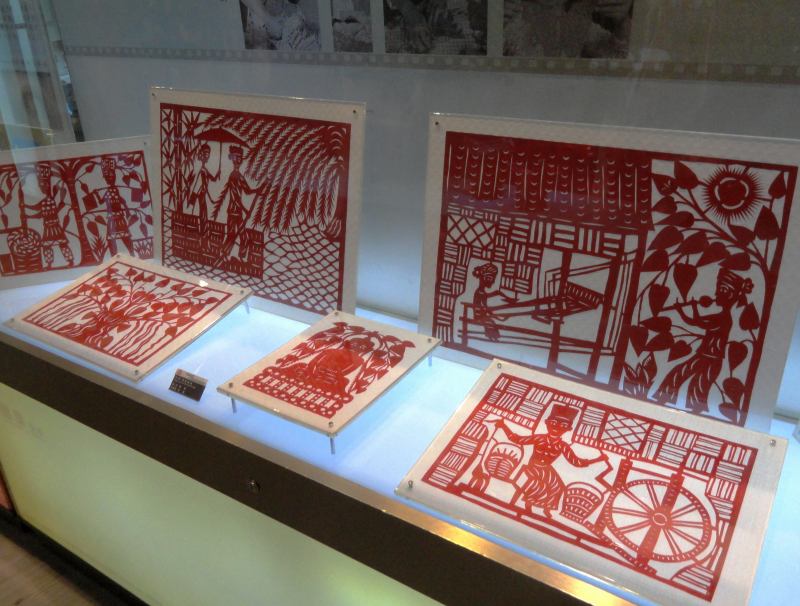
As it is primarily a rural art-form the images can be of local traditions about life going-on around them. Portrayal of symbols of fertility and protection against evil are common. Rats and rabbits known for their rapid breeding are popular elements to associate with items for marriage celebration. Symbols of coiled snakes can be seen in paper-cuts and earthenware dating back 5,000 years. Individual tribes chose particular animals as their emblem and the yin-yang association of animals is often evident. Where two animals are shown combined (fish with a cockerel's head) they can represent the harmonious union of yin and yang. In art peony may represent male (or yang) and lotus the female (or yin). An ancient paper-cut of five dolls, hand-in-hand is still sometimes used as a talisman against illness in Shaanxi but it is traceable back to the Yangshao culture 6,000 years ago. Another ancient paper-cut is a baby with coiled hair holding a fish often seen at weddings. These ancient, complex compositions are now hard to find.
Astrological animals
The twelve astrological animals of the Chinese zodiac are popular subjects for paper-cuts. There are many forms of the zodiac available, this set are comparatively easy to make.
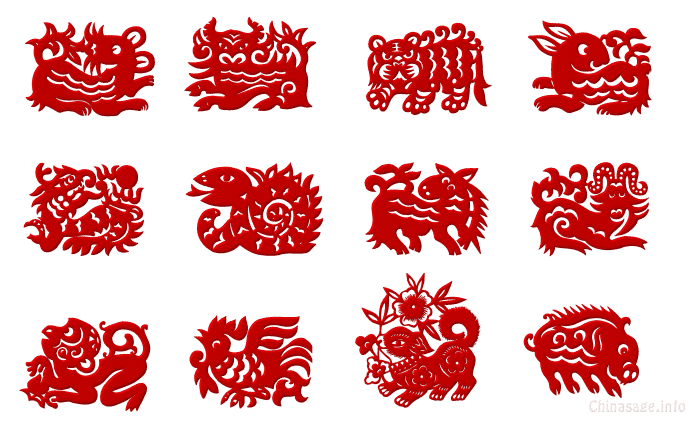
All twelve animals of the twelve year cycle.
Ancient subjects
Some paper-cut motifs have roots in myths and legends going back thousands of years.
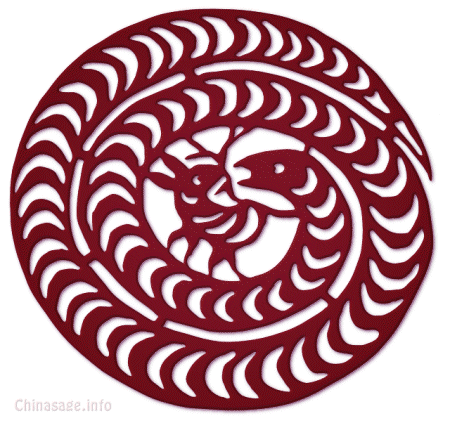
A coiled snake is an ancient emblem that can be traced to the Neolithic pottery designs of the Yangshao culture. A rabbit is an emblem of good fortune and is being nurtured rather than eaten by the snake.

Five linked dolls/babies is an ancient form. It can be traced back 5,000 years in Qinghai province. It is a simple paper-cut to make requiring just five folds followed by cutting out with a knife. The five figures represent the five directions (north, south, east, west and center) and form a talisman to keep out evil from wherever it may come.
Symmetric patterns
In this style the repeating pattern is made by first folding the paper and then cutting through several layers. Complex patterns can be made by folding at one place, cutting and then folding somewhere else. This is the more familiar form of paper-cut found in the west. Western designs tend to be of simple circular form - a circle is folded into quadrants and then cut to produce a symmetric pattern within a circle. Chinese papercuts use more complex forms on oblong or square paper. You need to use thin paper, typically rice paper, to be able to fold it multiple times and still cut it easily. By folding once you get a mirror image pattern - useful for things like butterfly wings. Two folds give a square design, three a hexagonal design, four an octagonal design and so on.
Hidden Meanings
Chinese art-work is very rich in symbolism and there is often an implied meaning of paper-cut designs that you should understand because this may make them unsuitable gifts.
A pair of mandarin ducks cut from red paper was a common gift for a married couple as the pair represent life-long fidelity. There are many creatures and plants that are used in paper-cuts to give a specific meaning. For example pomegranates, qilin, lotus, bamboo, fish, bat, pine trees - please see our symbolism section for an extensive list of them. Some are abstract symbols for example: ‘Eight diagram gourd’, ‘China net’, ‘Endless knot’ and ‘Gourd over a square’ but most are simplified forms of animals and plants.
Characters as Paper-cuts
Quite often the paper cut is an artistic form of single characters such as 福 fú ‘good luck’; 囍 xǐ ‘double happiness’ especially for weddings and 寿 shòu ‘long-life’ for birthdays.
Modern designs
In the days of the Cultural revolution designs moved from traditional to a revolutionary theme. The Lu Xun art school ➚, Shaanxi established in 1938 spearheaded the move to show scenes of everyday life out in the countryside - often showing the new power lines, irrigation and roads to laud rural modernization. Scenes from the new revolutionary operas (promoted by Jiang Qing) as well as revolutionary posters were also used for paper-cut designs. After the fall of the Gang of Four styles turned back to more traditional forms. Modern artists have now pushed the art-form in new, innovative directions. Some use computers to generate complex 3-D paper sculptures that would be impossible to do by hand.
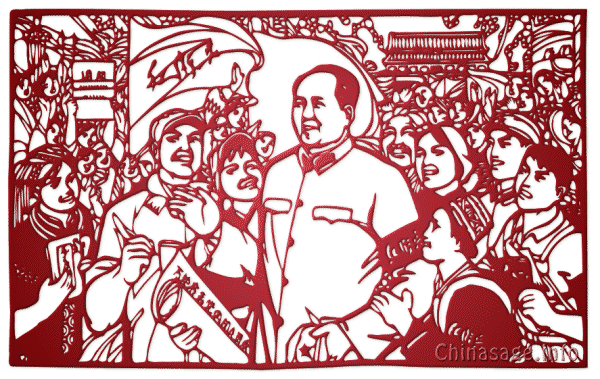
There are a number of living artists who are making new style paper-cuts, these include Bovey Lee ➚, Leah Wong ➚, Nahoko Kojima ➚, Xin Song ➚ and Qiao Xiaoguang ➚.
Three Dimensional Paper-cuts
Although Origami ➚ is a Japanese name for something widely regarded as originating in Japan, in fact the form has its roots in China. The combination of cutting and folding to build 3-D images dates back to the Song dynasty which predates the first documented Japanese mention in 1680. In China origami paper sculptures are known as 折纸 zhé zhǐ ‘fold paper’. They are mainly associated with funerals, where representations of everyday objects are made and then ritually burned to join the spirit of the deceased.
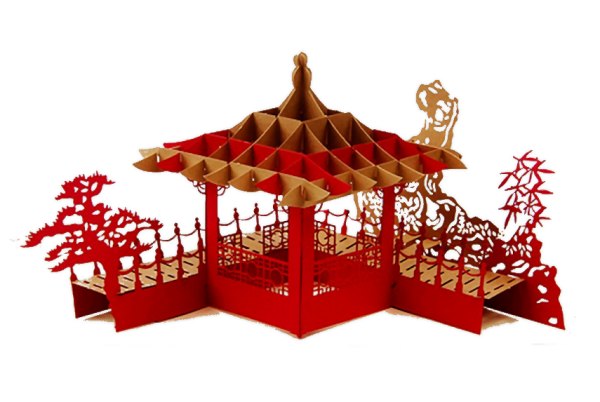
It is possible to build up complex scenes with paper card. This scene includes a pavilion, pine trees and bamboo.
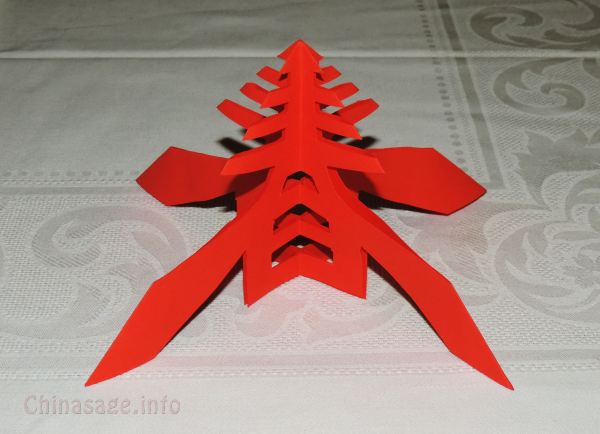
An attractive but simple 3-D paper-cut of the character for Spring 春 chūn so this is very suitable for Chinese New Year (Spring festival) .
Miscellaneous paper-cuts
Here are some designs that do not fit the previous categories.
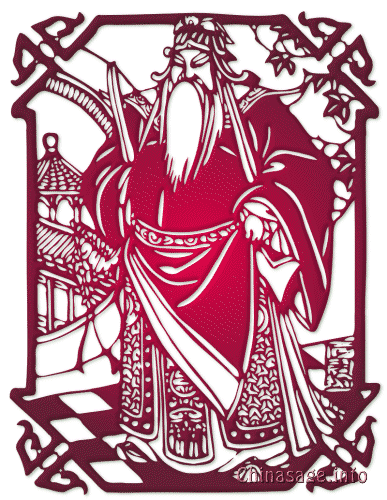
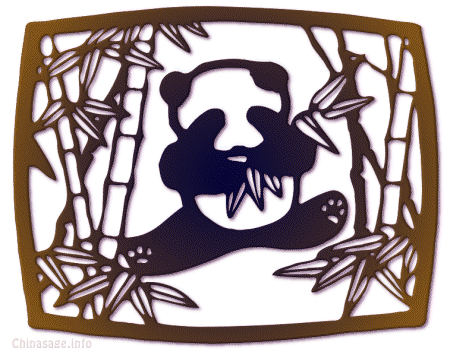
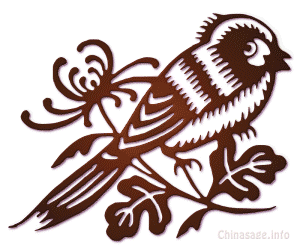
Regional variations
Each region of China has its own special subjects and styles, bolder in the north while more intricate in the south . Paper-cuts are less frequent in the far south because the moist tropical air soon attacks the paper. Regions have their own favorite subjects and motifs; in the south: Foshan, Guangdong and Fujian are all well known areas for paper-cuts. Further north in Zhejiang and Jiangsu the style often uses animals, birds and fish. The provinces of ‘old China’ (Shanxi, Shaanxi and Shandong) all have their distinctive provincial styles. Paper-cuts can be pasted over lintels, windows, lanterns, mirrors for many types of celebration. Paper-cuts on the ceiling were ‘Ceiling flowers’ and those on posts or lintels ‘Good luck hangings’.
Paper-cuts used for design
Many designs have started off as paper-cuts but then have been applied to porcelain, lacquer-work or embroidery.
Paper-cuts were often used as a way of transferring a design to something else as a stencil. If a paper-cut is stuck to wood and carved around then a 'wood block' scene is created that can then be inked to produce an indefinite number of copies. The paper-cut origin is evident if all the elements are joined. It could also be used to transfer designs onto porcelain or lacquer-work. In embroidery the paper-cut would be colored to provide the outline of the design to be tacked over with thread.